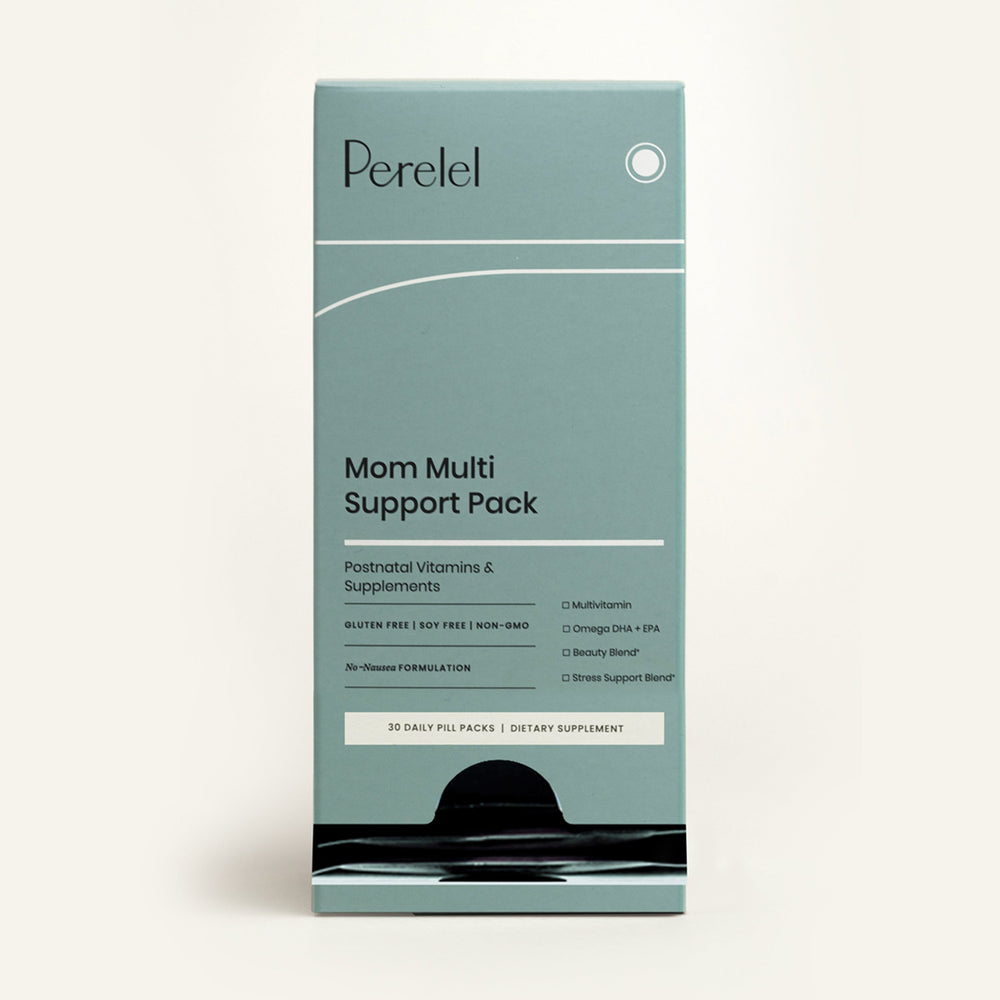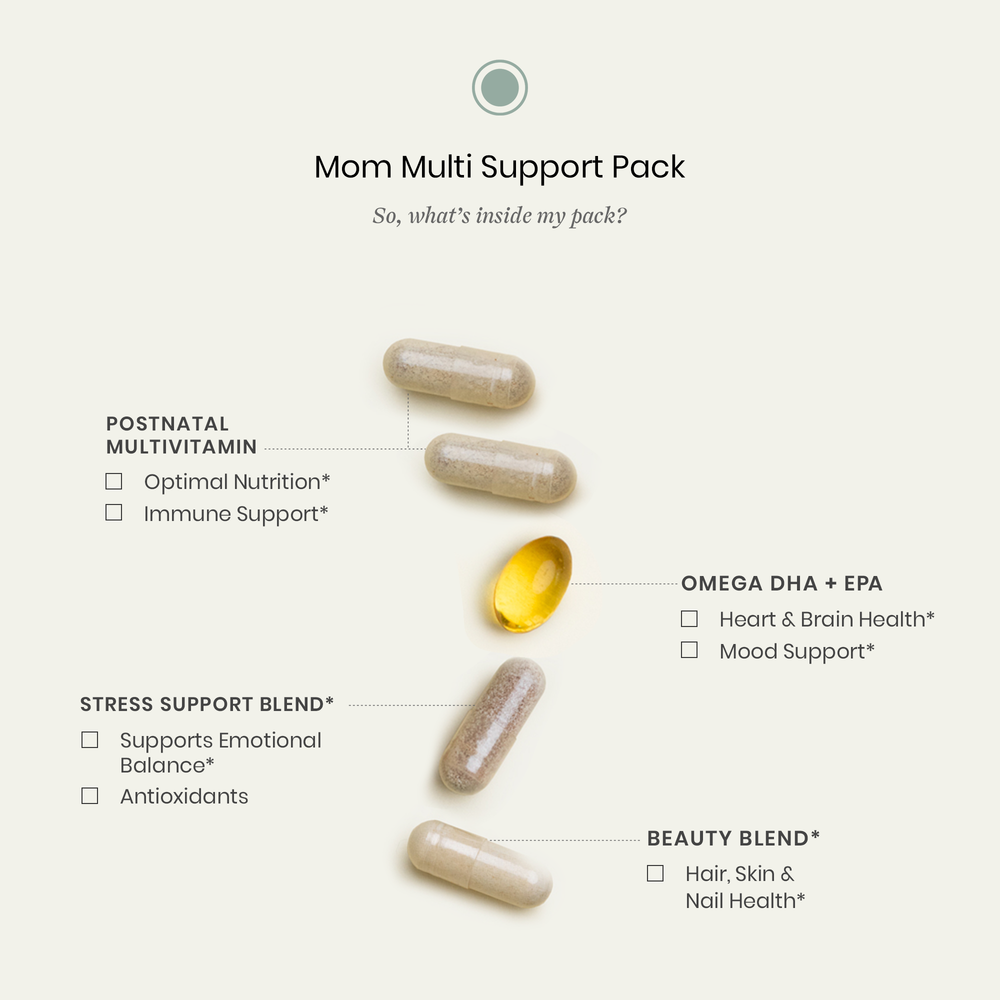If you’ve ever stood in the shower with a clump of strands in your palm you know the pain that comes from hair loss. Watching your hair go down the drain can feel shocking, deflating, and even infuriating to experience, yet it’s a common symptom many women endure–especially after childbirth or times of stress. If you’re in the thick of it—pun intended—read on to learn exactly how much hair loss is normal, and when to consider treatments.

Is My Hair Loss Normal?
According to the American Academy of Dermatologists, it’s normal to lose anywhere from 50 to 100 strands of hair per day.1 Seem like a lot? Keep in mind there are 100,000 hair follicles —or more—on each person’s scalp, which puts that number into context. If you’re noticing a greater loss, deemed “excessive hair shedding,” it can point to an underlying issue or stressor.1
Excessive hair shedding is common in people who have experienced one of the following stressors: dramatic weight loss, childbirth, emotional stress, high fever, a medical operation, illness, an autoimmune disease like alopecia, or have stopped taking birth control pills.1 If you are experiencing excessive hair loss, we always recommend talking to your healthcare practitioner to help identify the underlying cause.
Postpartum Hair Loss 101
It’s important to note that hair loss often happens a few months after the stressful event, not immediately. In the case of postpartum mothers, a new mom can see excessive hair shedding about two months after giving birth. The shedding usually peaks about four months after giving birth.1 Postpartum shedding is caused by falling estrogen levels which transition the hair from the growth cycle to the shedding cycle. But here’s the good news: it’s temporary. Most women see their hair return to its normal fullness by their child’s first birthday.2
When Will My Hair Grow Back?
As your body adjusts, the excessive shedding stops. Within six to nine months, the hair tends to regain its normal fullness, according to the American Academy of Dermatologists.1 However, if the stressor stays with you, hair shedding can be long lived. People who are constantly under a lot of stress can have long-term excessive hair shedding.
While the rate of hair growth can vary based on many factors, one 2016 study found that hair growth can also vary depending on race and ethnicity. What's that mean by the numbers? On average, Asian hair grows about .49 inches per month, or just under 6 inches per year. Black hair grows about .33 inches per month, or just under 4 inches per year. And white and Latino hair grows about .44 inches per month, or 5.3 inches per year.2
Doing the math on what that means? Bottom line is it can take months to years for your hair to regain fullness and length—and that rate is completely normal.
5 Tips to Help with Hair Growth
While hair growth can vary due to many factors, there are ways to take matters into your own hands and help your strands revive themselves.
Shop the Article:
-
Boost Your Nutritional Intake
Specific vitamins and minerals may boost hair growth and overall health. Look to biotin, collagen, vitamin C, vitamin D, vitamin E, zinc, iron, and your omega-3s—all of which can be found in all of Perelel’s vitamins, including our Women’s Daily Vitamin Trio and Mom Multi Support Pack. Both daily vitamin packs include a full-spectrum multivitamin, Omega DHA + EPA and Beauty Blend capsule we added specifically to support healthy hair, skin and nails.4* -
Try a Scalp Massage
While a scalp massage might just sound like a relaxing ritual, one small study showed that daily 4-minute scalp massages resulted in thicker hair. It’s thought that scalp massage may dilate blood vessels beneath the skin, resulting in thicker, stronger hair.4 -
Limit Heat Styling
You likely know that heat styling can damage your hair and cause breakage. Decreasing the frequency of usage, and the temperature on your tools is a strategic way to protect your hair and boost its health. Studies have also proved the efficacy of heat protectant products in protecting your hair while using heat tools.5
-
Trim Regularly
Consider this your reminder that regular trims aid in hair growth by removing split ends and preventing them from spreading further up your hair to cause breakage. While it might seem counterintuitive that regular trims would create longer hair, it’s important to snip when strands are damaged.
-
Reduce Stress
Studies prove that chronic stress can lead to hair loss.6 Sigh. We know, the last thing you want to hear when you’re stressed is that your hair is about to fall out because of it. But this correlation is an important reminder that your physical health is intrinsically tied to your emotional and mental wellbeing, and doing what you can to stay balanced will only benefit your body–and your strands.

No matter what phase you’re in, Perelel vitamins are formulated by doctors to support your total wellbeing–including hair growth and health. Shop the complete line here.
Jessica Lopez is a writer and new mother based in Southern California. She has written for Cup of Jo, BRIDES, Byrdie, THE/THIRTY, and more, and she currently enjoys (over)thinking and writing about parenthood. You can connect with her on Instagram, if you’d like.
1 Routine Hair Shedding: Why It Happens and How Much to Expect; Healthline
2 Diversity in human hair growth, diameter, color and shape. An in vivo study on young adults from 24 different ethnic groups observed in the five continents; L'OREAL Research and Innovation
4 How to Make Your Hair Grow Faster and Stronger; Healthine
5 Crystallin Fusion Proteins Improve the Thermal Properties of Hair; PubMed Central
Anatomy, Hair; National Library of Medicine
This article is for informational purposes only. It is not, nor is it intended to be, a substitute for professional medical advice, diagnosis, or treatment and we recommend that you always consult with your healthcare provider. To the extent that this article features the advice of physicians or medical practitioners, the views expressed are the views of the cited expert and do not necessarily represent the views of Perelel.





